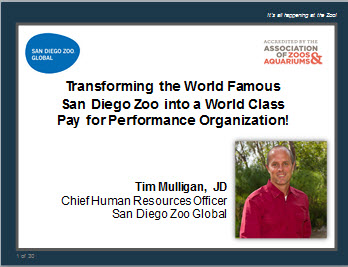 |
Pay for Performance |
1.00 |
Pay-for-Performance continues to be a major challenge for the majority of organizations as they try to find ways to make these programs meaningful to employees . Four years ago, the San Diego Zoo was struggling with how to best measure performance, manage goals and transform the organization into a pay-for-performance driven culture. Under the leadership of Tim Mulligan, the San Diego Zoo implemented a complete overhaul of its employee performance and talent management processes and systems, including appraisals and pay-for-performance. The end result was complete transformation of the Zoo's culture. Now the organization's more than 3,000 employees have clear goals and a link between day to day performance and their compensation which has resulted in greater accountability, increased productivity and higher employee morale. |
 |
Penguins |
2.00 |
Penguins delight and fascinate zoo visitors, but there's more to these ocean-dwelling birds than meets the eye. From Antarctica to the equator, birds in the order Spheniscidae have adapted to a unique existence that is tied to the land and to the sea. |
 |
Coaching: Coaching Diverse Employees |
1.34 |
People are different. Beliefs, behavior, learning pace, and personality vary from person to person. Some employees require extensive support to complete a project, while others perform better with fewer guidelines and more control. Still other employees need constant motivation to keep them focused on achieving goals.
As a coach, you must assess each employee’s situation, and determine the most effective coaching approach to implement. This versatility will help you recognize your employees’ needs, improve your communication skills, and make you a better coach.
In this course you will learn to: motivate employees by identifying their individual personality types, and build trusting relationships between employees and their coaches. |
 |
Coaching: Coaching Diverse Employees (Instructor Guide) |
1.34 |
People are different. Beliefs, behavior, learning pace, and personality vary from person to person. Some employees require extensive support to complete a project, while others perform better with fewer guidelines and more control. Still other employees need constant motivation to keep them focused on achieving goals.
As a coach, you must assess each employee’s situation, and determine the most effective coaching approach to implement. This versatility will help you recognize your employees’ needs, improve your communication skills, and make you a better coach.
In this course you will learn to: motivate employees by identifying their individual personality types, and build trusting relationships between employees and their coaches.
This Instructor's Edition of this course includes notes and suggestions to assist you in presenting the material, whether in an in-person classroom setting or as an instructor-led online or distance-learning course. It also provides you with the answers to questions found in mid-lesson activities, as well as in the quiz that concludes the course. |
 |
Managing Performance: Performance Management Basics |
1.00 |
Performance management is a process that allows for ongoing communication between employees and managers that results in employees striving for, and reaching, their potential.
In this course you will learn to: define performance management and identify its common pitfalls, understand the importance of creating a performance management plan and the steps involved in establishing a plan, and identify the process for discussing and creating an effective job description. |
 |
Outdoor Personal Protective Equipment (PPE) |
0.50 |
Personal protective equipment, commonly referred to as “PPE,” is equipment worn to minimize exposure to various hazards. Examples of PPE include gloves, foot, and eye protection, protective hearing devices (earplugs, muffs), hard hats, respirators, and full-body suits. This course covers protecting yourself from hazardous work-related activities with Personal Protective Equipment. |
 |
Course 29: Making Plans and Developing Policies |
2.00 |
Planning and policy-making are closely linked to the development of quality OST programs. When OST staff are skilled as planners and policy-makers, they can use these skills to design and implement high quality programs that benefit children, youth, and families. It is essential for OST professionals to recognize that it is important for policies to grow out of a vision of quality and a mission that supports that vision. Therefore, creating a vision for quality, developing a program philosophy, and writing a clear mission statement are the first steps in program planning. It is also important for OST professionals to use a systematic process to develop goals and objectives, set priorities for accomplishing goals and objectives, and develop goal-based action plans that will help the OST program achieve its mission. High quality OST programs are led by professionals who understand how to use effective strategies for creating a continuous cycle of planning and evaluation that supports ongoing program improvement. |
 |
Making Plans and Developing Policies |
2.00 |
Planning and policy-making are closely linked to the development of quality school-age care programs. When school-age staff are skilled as planners and policy-makers, they can use these skills to design and implement high quality programs that benefit children, youth, and families. It is essential for school-age care professionals to recognize that it is important for policies to grow out of a vision of quality, and a mission that supports that vision. Therefore, creating a vision for quality, developing a program philosophy, and writing a clear mission statement are the first steps in program planning. It is also important for school-age care professionals to use a systematic process to develop goals and objectives, set priorities for accomplishing goals and objectives, and develop goal-based action plans that will help the school-age program achieve its mission. High quality school-age programs are led by professionals who understand how to use effective strategies for creating a continuous cycle of planning and evaluation that supports ongoing program improvement. |
 |
Course 15: Designing Effective Indoor School-Age Play and Learning Environments |
2.00 |
Planning effective environments is the first step to planning an effective program. When environments are attractive, interesting, and comfortable, they provide a backdrop for a varied program that can address the developmental needs of school-age children. The look and feel of well-planned environments send messages that let children know they are welcome and valued. They are inviting and encourage children to get involved and stay engaged with program activities and experiences |
 |
Designing Effective Indoor Play and Learning Environments for School-Age Programs |
2.00 |
Planning effective environments is the first step to planning an effective program. When environments are attractive, interesting, and comfortable, they provide a backdrop for a varied program that can address the developmental needs of school-age children. The look and feel of well-planned environments send messages that let children know they are welcome and valued. They are inviting and encourage children to get involved and stay engaged with program activities and experiences. |
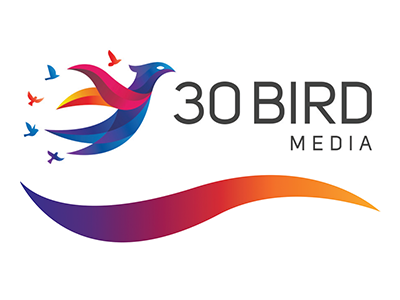 |
PMP® Certification: Passing the 2021 Exam |
40.00 |
PMP® Certification: Passing the 2021 Exam provides the basic knowledge needed to learn the concepts and skills necessary to pass the 2021 Project Management Professional (PMP) exam administered by the Project Management Institute (PMI). It is intended to be used alongside the PMBOK® Guide, Sixth Edition, which is useful as an ancillary reference and glossary.
The new release of this course (R2.0) includes a new chapter on agile approaches to, and tools for, the project life cycle. These methods address projects that require an adaptive project environment, iterative activities, and changing requirements. The standard example of adaptive project needs is that of software development and revision; however, agile methods are used today in many different project environments, from architecture to medical equipment and services. The new chapter (Managing projects with agility) was inserted at the end of the book. There were no other changes to the rest of the content, including the Exam Prep add-on.
This course assumes that you have project management and other educational experience, as required by PMI, in order to take the exam. In addition, it’s expected either that you have already applied to take the exam, or that you plan to do so while taking this course or shortly thereafter; this course contains instructions for doing so. |
 |
Organizational Communication: Power, Politics, and Diversity |
0.75 |
Power is the ability to influence someone to do something that they would not do without encouragement. Various types of power and power strategies depend on the level of influence. The existence of different levels of power in an organization gives rise to organizational politics.
Politics can arise between individuals who differ from each another. To avoid confrontation arising from differences, it is important for people to recognize the benefits of diversity within their organization.
In this course you will learn to: identify different levels and types of power, identify strategies to manage diversity and to communicate in different cultures, and identify the steps and guidelines for empowerment. |
 |
Organizational Communication: Power, Politics, and Diversity (Instructor Guide) |
0.75 |
Power is the ability to influence someone to do something that they would not do without encouragement. Various types of power and power strategies depend on the level of influence. The existence of different levels of power in an organization gives rise to organizational politics.
Politics can arise between individuals who differ from each another. To avoid confrontation arising from differences, it is important for people to recognize the benefits of diversity within their organization.
In this course you will learn to: identify different levels and types of power, identify strategies to manage diversity and to communicate in different cultures, and identify the steps and guidelines for empowerment.
This Instructor's Edition of this course includes notes and suggestions to assist you in presenting the material, whether in an in-person classroom setting, or as an instructor-led online or distance-learning course. It also provides you with the answers to questions found in mid-lesson activities, as well as in the quiz that concludes the course. |
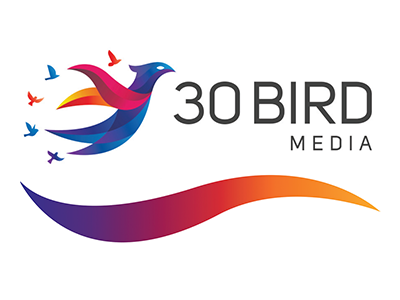 |
Microsoft PowerPoint 2019 Complete |
16.00 |
PowerPoint 2019 Complete covers the concepts and skills needed for maximum productivity in PowerPoint, starting with fundamentals and working up to advanced tools and techniques. This course maps to the objectives of the Microsoft Office Specialist exams for PowerPoint 2019. Objective coverage is marked throughout the course, and you can download an objective map for the series.
Students will benefit most from this course if they want to start with the basics and become power users of 2019. The course covers how to create, navigate, format, and customize PowerPoint presentations, as well as advanced features such as animation, transition techniques, adding and formatting media, track corrections, working with multiple presentations, creating custom slide shows, and working with security and sharing options.
The course assumes students know how to use a computer, and that they're familiar with Microsoft Windows. It does not assume that they've used a different version of PowerPoint or any other presentation program before. |
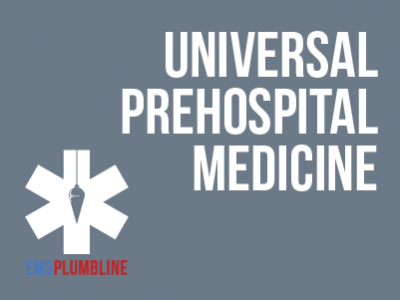 |
Popular Tourniquets |
1.00 |
Prehospital trauma care has not seen many changes that rival the advent of tourniquets. There is a lot of material that is nice to know. This lesson is a brief review of what we believe medics need to know. Successful completion of this lesson will set the stage for higher-level conversations. More importantly, we hope that you will be encouraged to practice applying the tourniquets until you have obtained true proficiency. Final Exam: This multiple-choice exam is designed to test your knowledge of the material you just reviewed. You have two attempts to gain an 80% or higher on this exam. Please take your time and answer each question carefully.
|
 |
Principles of Geriatric Pharmacotherapy |
1.00 |
Principles of Geriatric Pharmacotherapy, designed for health care professionals, teaches you how to identify treatment goals in older adults. Problems of aging are covered, such as the physiologic changes of the older population. Furthermore, this module identifies tools available to prevent inappropriate prescribing of medication, specifically highlighting the Medication Appropriateness Index, the Beers Criteria, and the STOPP/START Criteria. Some specific medications are discussed that require special care when prescribing them. Finally, you will learn how to ensure safe medication use in older adults. |
 |
Business Problem Solving: Problem Solving in the Corporate World (Instructor Guide) |
0.84 |
Problem-solving cultures greatly influence the problem-solving process in organizations. Recognizing the culture that exists in your organization will permit you to develop effective solutions. This approach needs employees with a wide variety of skills and talents.
In this course you will learn to: identify the types of problem solvers and the skills they must possess, and identify different corporate cultures.
This Instructor's Edition of this course includes notes and suggestions to assist you in presenting the material, whether in an in-person classroom setting or as an instructor-led online or distance-learning course. It also provides you with the answers to questions found in mid-lesson activities, as well as in the quiz that concludes the course. |
 |
Business Problem Solving: Problem Solving in the Corporate World |
0.84 |
Problem-solving cultures greatly influence the problem-solving process in organizations. Recognizing the culture that exists in your organization will permit you to develop effective solutions. This approach needs employees with a wide variety of skills and talents.
In this course you will learn to: identify the types of problem solvers and the skills they must possess, and identify different corporate cultures. |
 |
Business Problem Solving: Problem-Solving Basics (Instructor Guide) |
1.25 |
Problem-solving is aimed at eliminating problems. The problem-solving process involves identifying a problem, gathering information, generating and evaluating options, and implementing solutions.
Effective problem-solving needs the coordination of knowledge, experience, attitude, intuition, and the abilities of an individual or team. By successfully eliminating problems the first time, you will save your company’s resources and improve its operation.
In this course you will learn to: define the fundamentals of problem-solving, and identify effective problem-solving approaches.
This Instructor's Edition of this course includes notes and suggestions to assist you in presenting the material, whether in an in-person classroom setting or as an instructor-led online or distance-learning course. It also provides you with the answers to questions found in mid-lesson activities, as well as in the quiz that concludes the course. |
 |
Business Problem Solving: Problem-Solving Basics |
1.25 |
Problem-solving is aimed at eliminating problems. The problem-solving process involves identifying a problem, gathering information, generating and evaluating options, and implementing solutions.
Effective problem-solving needs the coordination of knowledge, experience, attitude, intuition, and the abilities of an individual or team. By successfully eliminating problems the first time, you will save your company’s resources and improve its operation.
In this course you will learn to: define the fundamentals of problem-solving, and identify effective problem-solving approaches. |
 |
Business Problem Solving: Problem-Solving Teams (Instructor Guide) |
1.00 |
Problem-solving teams are created to solve a specific business problem. Ideally, such a team should have members from different departments of your organization. However, you need to develop skills to focus team members on a common goal.
As a team leader, you might be expected to create a team, rather than simply manage a group of people assigned to complete a task. You will play a central role in helping team members interact, communicate, and work together. You will also be expected to plan and execute team meetings. Meetings can be an effective way to communicate information to the group, to decide on an action, to set goals, and to motivate and support team members.
In this course you will learn to: build and manage problem-solving teams and conduct effective meetings, and motivate team members and effectively communicate with them.
This Instructor's Edition of this course includes notes and suggestions to assist you in presenting the material, whether in an in-person classroom setting or as an instructor-led online or distance-learning course. It also provides you with the answers to questions found in mid-lesson activities, as well as in the quiz that concludes the course. |
 |
Business Problem Solving: Problem-Solving Teams |
1.00 |
Problem-solving teams are created to solve a specific business problem. Ideally, such a team should have members from different departments of your organization. However, you need to develop skills to focus team members on a common goal.
As a team leader, you might be expected to create a team, rather than simply manage a group of people assigned to complete a task. You will play a central role in helping team members interact, communicate, and work together. You will also be expected to plan and execute team meetings. Meetings can be an effective way to communicate information to the group, to decide on an action, to set goals, and to motivate and support team members.
In this course you will learn to: build and manage problem-solving teams and conduct effective meetings, and motivate team members and effectively communicate with them. |
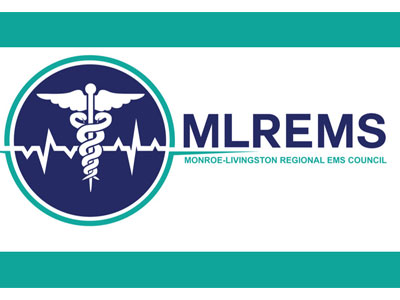 |
Constructing: FAST-ED Overview |
1.00 |
Professor of Emergency Medicine and Chief of the Division of Prehospital Medicine at the University of Rochester, Jeremy Cushman, brings his experienced team of prehospital providers together to discuss the benefits of Field Assessment Stroke Triage for Emergency Destination (FAST-ED). You will want to take notes and download your favorite smartphone app. This lesson is sure to spark an excellent discussion with your training officers and/or medical director(s).
Final Exam: This multiple choice exam is designed to test your knowledge of the material you just reviewed. You have two attempts to gain an 80% or higher on this exam. Please utilize the smartphone app of your choosing and take your time and answer each question carefully. |
 |
Microsoft Project 2019 Complete |
16.00 |
Project 2019 Complete covers the concepts and skills needed for maximum productivity in Project, starting with fundamentals and working up to advanced tools and techniques.
Students will benefit most from this course if they have at least some prior knowledge of project management procedures and practices. It is intended to support you in applying this knowledge through the use of Microsoft Project as a project management tool. Some of the topics covered are:
- Creating a new project schedule from scratch
- Understanding and working with task types, scheduling options, and task constraints
- Working with resources, including scheduling and assignment
- Managing the project schedule in accordance with the critical path and project baseline
- Printing project views, dashboards, and various other kinds of reports.
- Working with the Quick Access Toolbar and advanced calendar topics
- Setting resource working-time exceptions, pooling resources for sharing, and creating resource budget cost items
- Working with multiple baselines and interim plans
- Resolving resource conflicts and scheduling issues
- Consolidating projects using Master projects and Subprojects
- Working with Project Server, Project Online, and SharePoint
- Using Project data in other applications
- Creating final reports
There are no specific prerequisites for this course. However, general computer user knowledge is assumed. Any additional experience having worked with forms and/or databases will be helpful. |
 |
Project Teams: Creating a Project Team (Instructor Guide) |
1.00 |
Project teams and non-project teams are similar because they both often have specific time frames in which to complete tasks. However, project teams also have a time frame for the life of the team, whereas non-project teams usually don’t. A non-project team might be established to monitor the effectiveness of an organization’s advertising. The need to monitor advertising effectiveness will be ongoing, and the team will not have an ending date.
In this course you will learn to: identify the characteristics of a project team, and understand who the project stakeholders are, and understand how individual responsibilities and stress affect a project team, and how team members can evaluate their performance.
This Instructor's Edition of this course includes notes and suggestions to assist you in presenting the material, whether in an in-person classroom setting, or as an instructor-led online or distance-learning course. It also provides you with the answers to questions found in mid-lesson activities, as well as in the quiz that concludes the course. |


























